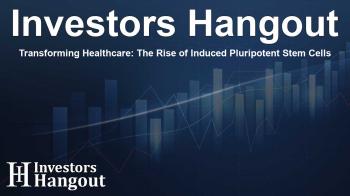Transforming Healthcare: The Rise of Induced Pluripotent Stem Cells

Overview of the Induced Pluripotent Stem Cells Production Market
The global market for Induced Pluripotent Stem Cells (iPSCs) is set to experience significant growth. According to recent analyses, the market value is projected to reach approximately USD 4.34 billion by 2034, reflecting a robust compound annual growth rate (CAGR) of 9.5% between 2025 and 2034. This surge is attributed to several factors, including advancements in therapeutic applications and increased funding for stem cell research.
Growth Factors Behind the iPSC Production Market
Key Market Drivers
One of the primary drivers propelling the iPSC production market is the growing utilization of iPSCs in fields such as drug development and regenerative medicine. These versatile cells allow researchers to create patient-specific cell types that significantly enhance disease modeling and testing. As the focus on personalized medicine intensifies, the demand for iPSC technology is expected to rise. Moreover, institutional investments and collaborations between biotech firms and academic research are fostering innovation and commercialization within this market.
The Role of Government and Private Investments
Government agencies and private investors recognize the potential of iPSCs. Increased funding is facilitating rapid advancements in reprogramming technologies and manufacturing processes, fostering a robust pipeline of iPSC-derived therapies. These investments are crucial for developing scalable, quality-controlled production processes compliant with good manufacturing practices (GMP), which further supports the growth of the market.
Technological Advances in iPSC Production
Innovations and Future Trends
Technological advancements are at the forefront of the iPSC production market. Recent innovations include automation and AI-driven analytics in bioprocess control, leading to enhanced reproducibility and cost efficiency. Closed-loop bioreactor systems are also being developed to facilitate large-scale cell production, which is vital for both research and clinical applications.
Furthermore, improving methodologies for cell reprogramming aims to enhance efficiency while minimizing genetic instability risks. This ensures that the resulting stem cells maintain high standards for clinical use and regulatory compliance, thereby broadening their therapeutic applications.
Challenges Facing the iPSC Production Market
Regulatory Barriers and Market Limitations
Despite the promising outlook, the iPSC market faces challenges, including stringent regulatory requirements which can delay commercialization. Each region has unique regulations that complicate global market entry, leading to increased operational costs and uncertainties for producers. Additionally, concerns regarding the safety of genetic stability and the potential for tumorigenicity in iPSC-derived products necessitate rigorous testing and validation, which can hinder progress toward clinical applications.
Operational and Technical Barriers
Operational challenges also pose threats to the market’s expansion. The intricate processes involved in cell reprogramming and characterization remain time-consuming and labor-intensive, requiring specialized skills and resources. Furthermore, the reliance on highly skilled personnel limits scalability and poses a bottleneck in production capacity.
Current Market Landscape and Future Prospects
Leading companies in the iPSC production market are continuously refining their strategies to maintain competitive advantages. These companies are emphasizing proprietary reprogramming and differentiation protocols, aiming to create GMP-compliant clinical-grade cell lines that can cater to high-value therapeutic applications.
The Importance of Collaborations and Partnerships
Collaboration between academic and industrial entities is pivotal for driving innovations in the iPSC space. Partnerships enable the merging of knowledge and resources, facilitating rapid advancement from bench research to clinical applications. This integrated approach not only enhances competitiveness but also helps in tackling technical challenges associated with iPSC production.
Conclusion: The Future of iPSC Production
As the demand for regenerative therapies continues to rise, the iPSC production market promises to evolve significantly. With proper support from governmental entities, innovation-driven companies, and academia, this market is poised for transformative growth, paving the way for groundbreaking therapies that could redefine modern medicine.
Frequently Asked Questions
What is the projected growth rate of the iPSC market?
The Induced Pluripotent Stem Cells production market is projected to grow at a CAGR of 9.5% from 2025 to 2034.
How will government investments impact the iPSC market?
Increased government investments are expected to accelerate innovation and commercialization of iPSC technologies, supporting further research and therapeutic developments.
What are the main applications of iPSCs?
iPSCs are widely used in drug development, regenerative medicine, disease modeling, and toxicology testing, enabling patient-specific therapies and drug efficacy testing.
What challenges does the iPSC market face?
The iPSC market faces challenges such as stringent regulatory frameworks, operational complexities, and the need for specialized skills for cell production.
How important are collaborations in the iPSC market?
Collaborations between academic and industry partners are crucial for driving innovation, sharing resources, and facilitating the transition of research findings into clinical applications.
About The Author
Contact Dylan Bailey privately here. Or send an email with ATTN: Dylan Bailey as the subject to contact@investorshangout.com.
About Investors Hangout
Investors Hangout is a leading online stock forum for financial discussion and learning, offering a wide range of free tools and resources. It draws in traders of all levels, who exchange market knowledge, investigate trading tactics, and keep an eye on industry developments in real time. Featuring financial articles, stock message boards, quotes, charts, company profiles, and live news updates. Through cooperative learning and a wealth of informational resources, it helps users from novices creating their first portfolios to experts honing their techniques. Join Investors Hangout today: https://investorshangout.com/
The content of this article is based on factual, publicly available information and does not represent legal, financial, or investment advice. Investors Hangout does not offer financial advice, and the author is not a licensed financial advisor. Consult a qualified advisor before making any financial or investment decisions based on this article. This article should not be considered advice to purchase, sell, or hold any securities or other investments. If any of the material provided here is inaccurate, please contact us for corrections.

